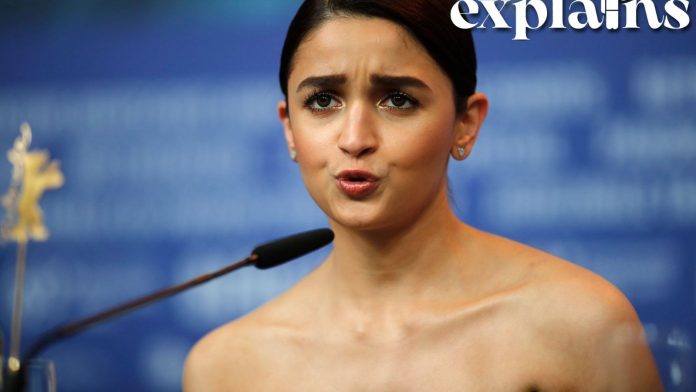[ad_1]
Bollywood actor Alia Bhatt on Tuesday turned to Instagram to express her outrage at the ‘invasion of privacy’ after a few photographers snapped her images while she was inside her home. The actor took to Instagram, tagged the Mumbai Police, and claimed that she believed she was being looked at. That’s when she noticed two paparazzi snapping photos of her from the top of a nearby building.
“Are you kidding me? I was at my house, having a perfectly normal afternoon, sitting in my living room when I felt something watching over me. I looked up and saw two men on the terrace of the neighbouring building with a camera right at me. In what world is this okay and is this allowed? This is a gross invasion of someone’s privacy. There’s a line that you must not cross, and it is safe to say that all lines were crossed today,” she wrote.
Various celebrities, including actor Anushka Sharma and director Karan Johar, sprang to Bhatt’s support and condemned the action on the part of the photographers.
Right to be Left Alone
The right to be left alone has been established by the US judiciary as privacy. Experts now believe that this approach is insufficient in today’s vastly interconnected globe, say reports.
In the case of Ram Jethmalani versus Union of India, the Supreme Court of India stated that “it is important that human beings be granted realms of freedom that are devoid of public observation unless they act in an unlawful manner.”
In a famous US case, the Missouri Supreme Court’s decision in Barber v. Time (1942), was one of the first to establish that the balance between an individual’s right to privacy and freedom of the press is determined by the judicial determination of “proper public interest,” rather than the truth or absence of malice in what is published, as per a report by First Amendment Encyclopedia.
In the case, a photographer clicked Dorthy Barber giving birth to a newborn boy. Ms. Barber had filed a lawsuit against Time Inc. for “Invasion of Privacy” for unlawful and aggressive entry into her hospital room and photographing her notwithstanding her protests. Ms. Barber was successful in her complaint, and the court awarded her $3000 in damages.
In India, such an invasion as seen in Alia’s case may also be identified as stalking by some. Stalking is defined in Indian Penal code under section 354D, and is defined as the continuous and repeated following of someone with the goal of creating harm or terror to the person being followed, or engaging in conduct directed towards another person that serves no legitimate purpose and gravely alarms, irritates, or intimidates that person.
The act of stalking is now a cognizable, bailable, and non-compoundable offence under the Criminal Amendment Act of 2013. For the first offence, up to three years in prison and a fine; for the second offence, up to five years in prison and a fine.
Fame as Intellectual Right
The right to exploit the economic value of an individual’s name and renown is known as publicity right, as per a report by Legal Services India. To assert this right, it must be demonstrated that fame is a type of merchandise, i.e. an act meant to promote the sale/popularity of a commodity or an activity. As a result, if someone leverages a celebrity’s renown to advertise his wares, it is considered an unfair trade practise, misuse of the celebrity’s intellectual property, passing off, and so on.
Taking the case of Sourav Ganguly v. Tata Tea ltd. as an example, Sourav Ganguly, who returned from Lords after scoring magnificent centuries, was extremely disturbed when he discovered that Tata Tea Ltd., where he was employed as a manager, was promoting its 1 kilo tea packet by offering consumers a chance to congratulate Sourav through a postcard which was included inside each packet of tea, the report says. In a way, the company’s intention was to indirectly promote the sale of its tea packets in the Indian market, where Sourav was well-known. The court ruled in Sourav’s favour, recognising that his celebrity status and popularity are his intellectual property.
Famous Cases of Paparazzi’s Invasion
A famous example of media frenzy around a celebrity can be attributed to what late Princess Diana, former wife of then Prince Charles III faced after her engagement was announced. She became a paparazzi favourite, with packs chasing her at almost instances in public life throughout her life.
Infact, when Princess Diana died due to a car accident, she and Dodi Fayed (who she was dating at the time) were trying to escape a pack of paparazzi who were trying to click the couple in Paris.
In the immediate aftermath of the Paris crash, French police detained photographers and press motorcyclists for questioning about their possible role in the deaths of Princess Diana and Dodi Fayed. A French judge who heard the case blamed their driver, Henri Paul, who had been drinking immediately before the incident, but a jury in a British inquest in 2008 concluded that Paul and the chasing photographers were “grossly negligent.”
In 2005, Hollywood actor Lindsay Lohan crashed her Benz while being pursued by a swarm of pushy paparazzi. Most importantly, it led to harsher sanctions for “stalkerazzi” who cross the boundary.
And who can forget the infamous stalking of Britney Spears at the height of her fame? In 2005 as well, a photographer was wounded in the leg with a pellet gun while scoping out a baby shower in Malibu, California, in the hopes of photographing the guest of honour, Britney Spears.
According to the Los Angeles Times, Brad Diaz, one of around 15 paparazzi stationed at the foot of the Malibu home’s driveway, was hit in the thigh by the plastic bullet. It was not determined where the shot had come from.
Read all the Latest Explainers here
[ad_2]




